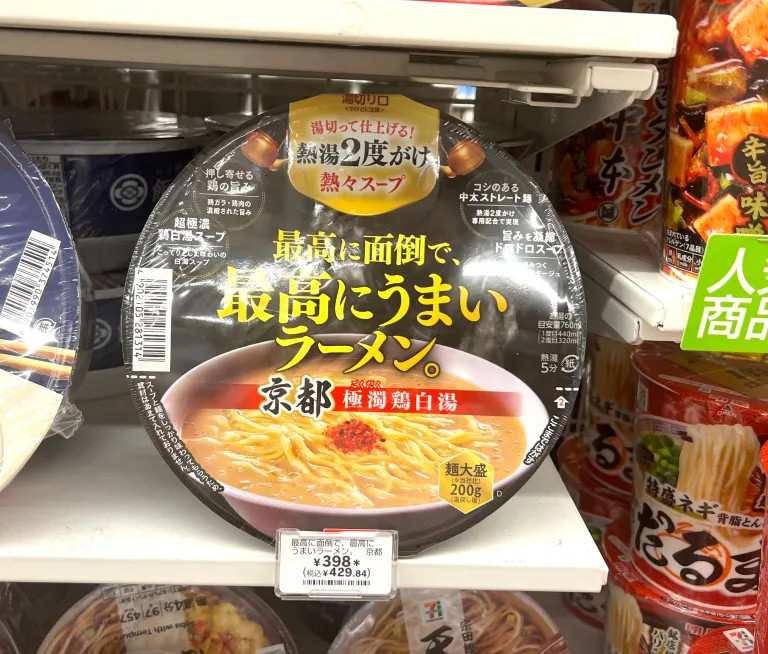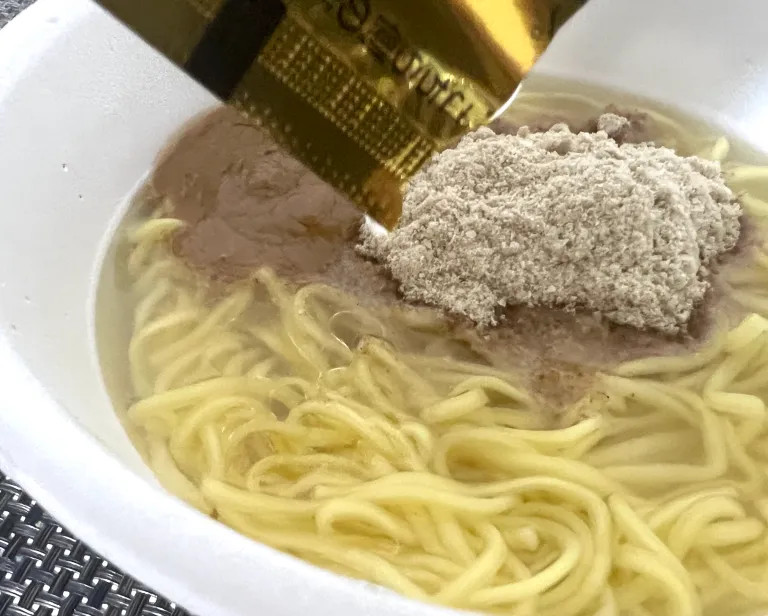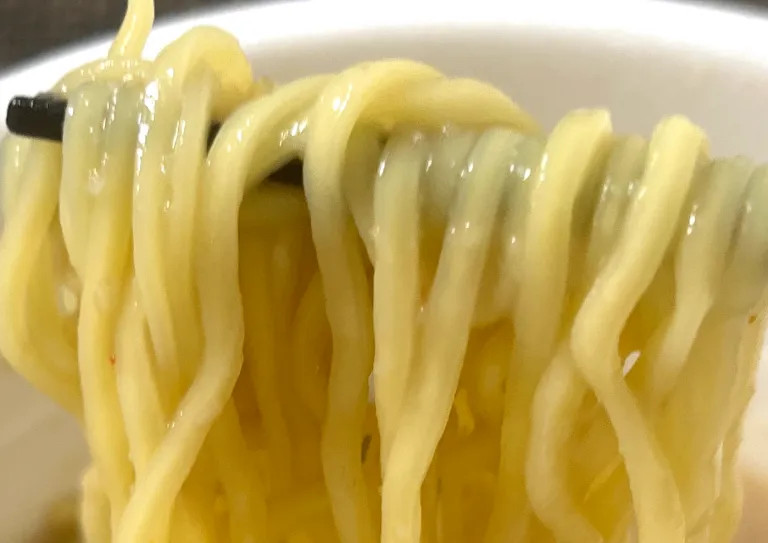
We don’t mind annoying, if the flavor is worth it.
Over the past year, 7-Eleven has been releasing different flavors of a special kind of cup noodles called the “Most Annoying but Most Delicious Ramen”, which are crafted to be extra delicious–but not quite as instant as you’d expect. Still, they’re worth the effort, so when we noticed that the third iteration had come out while we were shopping for 7-Eleven’s new Michelin-star ramen-flavored Baby Star snacks, we had to try it.
This ramen is called Kyoto Kyoku Nigori Tori Paitan (Super Cloudy Chicken White Broth from Kyoto), which, as you can guess from the name, is a ramen with a cloudy broth. In fact, it’s the first of the series to have a broth that isn’t clear, and this one is paitan, a bone broth made without soy sauce, which is also unusual. This piqued our interest even more.
We bought ours for 429 yen (US$2.90), which is pretty expensive for cup ramen.
The packaging boasted the new cloudy broth, as well as medium-thickness noodles that were straight instead of curly. The cooking method requires you to pour hot water over the noodles twice, which is somewhat unusual for cup noodles.
▼ “Straight noodles that are both firm and chewy! Formulated to be poured over with hot water twice”
One serving contains 152 grams (5.4 ounces) of food, amounting to 534 calories. Since the second MAMD Ramen clocked in at 699 calories, this one is almost restrained.
Under the lid, we found four different packets of powdered soup and toppings.
They were “Extremely Cloudy Umami Dashi Broth”, “Chicken Broth”, “Oil Flavoring”, and “Red Pepper Seasoning”, and all went in after the second addition of hot water.
The noodles are designed to be put in hot water twice…
So we poured in the first round of hot water…
Shut the lid, and, holding it closed by putting two of the seasoning packets on top, waited five minutes.
Then we opened up the strainer spout, poured out the first round of water…
And added the second round of hot water.
Then the seasonings and broths went in…
And it was ready!
There weren’t any vegetable of meat-like toppings, leaving the noodles and broth bare. We were impressed; this sent the message that the flavor would stand on its own. But was it good enough?
Hmmmm…
We’re not sure. The noodles were just a bit too soft for our tastes. We didn’t think we prepared them wrong, especially since the package explicitly states that they need two rounds of hot water, but we couldn’t help but feel that they were a bit too gooey.
The broth, however, we really liked. The packaging said it was “Like a chicken potage”, and it didn’t lie. It was so creamy and thick and of such high quality that they could sell the broth separately as a soup. Whether you like it or not may be down to personal preference, though, since such a thick broth is pretty uncommon for ramen.
So in the end, our only complaint was with the noodles, which is why we can’t accept that this ramen has the title of “Most delicious.” Well, it wasn’t so bad, since we enjoyed the soup so much that we finished the whole thing.
Still, we couldn’t help but think of ways to really bring this cup ramen to the “Most Delicious” level, so we decided to experiment.
Our first hypothesis was that perhaps these noodles don’t need to be cooked as long as five minutes. Since you add hot water again after they’re drained, they end up being cooked for far longer, which might be why the noodles ended up so soft.
With that in mind, we decided to let the noodles sit for three minutes, then test them every 30 seconds until they were cooked to our liking. That way we could determine the proper time needed to cook the noodles to perfection before pouring out the water and adding more in.
We first checked them at the three-minute mark.
They weren’t quite done. They still had a floury taste. Another 30 seconds didn’t bring them to the right level either, but at four minutes, they were at just the right firmness that we hoped a second dousing of hot water would bring them to the perfect level of softness.
We finished up the cooking and added all the seasoning packets, and then gave it a taste…
Ohh! That was pretty good! As we guessed, we’d cooked the noodles just enough that they had a good level of chewiness that made them undeniably delicious. This time we didn’t even consider drinking the broth, and instead focused on slurping up all the noodles.
But there might be a way we could make this ramen even more delicious, so we decided to try another experiment. We went back to 7-Eleven and bought three different kinds of 7-Eleven brand fresh noodles: thin, medium thick, and extra thick. Each package cost 84 yen.
Our idea? To try different noodles in the same broth and see if that would elevate it. We cooked them separately according to package directions, then added them individually to the broth to test.
▼ From left to right: Extra Thick Noodles, Medium Thick Noodles, and Thin Noodles
First we tried the thin noodles.
They were pretty good! Since the noodles were thinner, they managed to absorb a lot more of the flavor of the soup, providing the perfect balance of soup and noodle. Plus, it was easy to scarf down.
Next we tried the “medium thick” noodles.
Texture wise, these noodles didn’t change much from the thin noodles. However, we did think that the thin noodles did a better job of meshing with the soup. The noodles that come in the cup were also of medium thickness, but since these noodles are fresh, they have a bit more of a floury taste that was more evident in these than in the thin noodles.
Lastly we tried the “extra thick” noodles.
Sadly, they were a miss. Since they’re so thick, they overpowered the soup in both taste and texture, and honestly, fresh noodles just didn’t seem like a good match for this broth. The flavors just didn’t pair well.
So in the end, the methods we tried to make the latest “Most Annoying but Most Delicious Ramen” from 7-Eleven truly “the most delicious” are ranked as follows:
First place: Cooking the original noodles for just four minutes
Second place: Using 7-Eleven’s Fresh Thin Noodles
Third place: Using 7-Eleven’s Fresh Medium Thick Noodles
Fourth place: Using 7-Eleven’s Fresh Extra Thick Noodles
Of course, personal preference plays a large role in whether or not you agree. Some people, for example, prefer their noodles to be on the soft side, and if that’s you, the “Most Annoying but Most Delicious Ramen Kyoto Kyoku Nigori Tori Paitan” is probably perfect the way it is. But if you’re somewhere else on the scale, then you can use our rankings to get an idea of where to start to make them exactly how you like them.
And for dessert, you might as well pick up 7-Eleven’s new mint chocolate whipped cream sandwiches while you’re there! Happy snacking!
Images © SoraNews24
● Want to hear about SoraNews24’s latest articles as soon as they’re published? Follow us on Facebook and Twitter!
[ Read in Japanese ]




























 We try 7-Eleven’s newly recreated Pork Ramen and are blown away by its level of perfection
We try 7-Eleven’s newly recreated Pork Ramen and are blown away by its level of perfection “THIS is Pork!” 7-Eleven’s pre-made chashu pork is here to elevate your instant ramen【Taste test】
“THIS is Pork!” 7-Eleven’s pre-made chashu pork is here to elevate your instant ramen【Taste test】 Ichiran Ramen’s delicious new product: Fried tonkotsu noodles!
Ichiran Ramen’s delicious new product: Fried tonkotsu noodles! 7-Eleven Japan’s ramen-cooking robot whipped us up a bowl of noodles【Taste test】
7-Eleven Japan’s ramen-cooking robot whipped us up a bowl of noodles【Taste test】 Super ramen! What happens when you combine 19 different types of supermarket ramen?【SoraKitchen】
Super ramen! What happens when you combine 19 different types of supermarket ramen?【SoraKitchen】 Cup Noodle tries an authentic Jiro-style ramen, but something’s not quite right
Cup Noodle tries an authentic Jiro-style ramen, but something’s not quite right We revisited Sweets Paradise after a decade to see if Japan’s dessert buffet still delivers
We revisited Sweets Paradise after a decade to see if Japan’s dessert buffet still delivers That time Seiji called JASRAC to ask why he didn’t get paid royalties for his song being on TV
That time Seiji called JASRAC to ask why he didn’t get paid royalties for his song being on TV Starbucks Japan ready to get Year of the Horse started with adorable drinkware and plushies【Pics】
Starbucks Japan ready to get Year of the Horse started with adorable drinkware and plushies【Pics】 What did Shibuya really look like after the crowds on New Year’s Day?
What did Shibuya really look like after the crowds on New Year’s Day? Our team of five reporters try to turn themselves into Japanese heartthrob Kimutaku【Photos】
Our team of five reporters try to turn themselves into Japanese heartthrob Kimutaku【Photos】 Survey finds more than 70 percent of Japanese children have an online friend
Survey finds more than 70 percent of Japanese children have an online friend Everyone in the office wears a bra in search of the true meaning of Brassiere Day
Everyone in the office wears a bra in search of the true meaning of Brassiere Day Pizza Hut Japan’s hot lucky bags are perfect for a New Year’s pizza party
Pizza Hut Japan’s hot lucky bags are perfect for a New Year’s pizza party The most preposterous “adult” gacha capsule toys at Akihabara Station
The most preposterous “adult” gacha capsule toys at Akihabara Station 7 great places to see Mt. Fuji from without having to climb it
7 great places to see Mt. Fuji from without having to climb it Cyberpunk anime meets traditional culture in Ghost in the Shell gold leaf Japanese changing screens
Cyberpunk anime meets traditional culture in Ghost in the Shell gold leaf Japanese changing screens Hayao Miyazaki says Happy New Year to Studio Ghibli fans with new art for Year of the Horse
Hayao Miyazaki says Happy New Year to Studio Ghibli fans with new art for Year of the Horse Hello Kitty Choco Egg figures are an adorable trip through three periods of Japanese pop culture【Pics】
Hello Kitty Choco Egg figures are an adorable trip through three periods of Japanese pop culture【Pics】 We found possibly the quietest Japanese-style hotel in Tokyo’s bustling Shinjuku district
We found possibly the quietest Japanese-style hotel in Tokyo’s bustling Shinjuku district 7-Eleven Japan’s ramen-cooking robot whipped us up a bowl of noodles【Taste test】
7-Eleven Japan’s ramen-cooking robot whipped us up a bowl of noodles【Taste test】 Sumo Sanrio! Hello Kitty and pals team up with Japan Sumo Association for new merch【Pics】
Sumo Sanrio! Hello Kitty and pals team up with Japan Sumo Association for new merch【Pics】 Japan’s oldest largetooth sawfish in captivity back on display in Mie Prefecture
Japan’s oldest largetooth sawfish in captivity back on display in Mie Prefecture More Than a Capsule Stay: Why Solo Travelers Choose “global cabin Yokohama Chinatown”
More Than a Capsule Stay: Why Solo Travelers Choose “global cabin Yokohama Chinatown” 7-Eleven Japan starts new temporary luggage storage service in over 300 branches
7-Eleven Japan starts new temporary luggage storage service in over 300 branches Disillusionment at Tsukiji’s tourist-target prices led us to a great ramen restaurant in Tokyo
Disillusionment at Tsukiji’s tourist-target prices led us to a great ramen restaurant in Tokyo Starbucks teams up with 166-year-old Kyoto doll maker for Year of the Horse decorations【Photos】
Starbucks teams up with 166-year-old Kyoto doll maker for Year of the Horse decorations【Photos】 Tokyo considering law requiring more trash cans following litter increase in heavily touristed area
Tokyo considering law requiring more trash cans following litter increase in heavily touristed area Tokyo’s Tsukiji sushi neighborhood asks tour groups to stay away for the rest of the month
Tokyo’s Tsukiji sushi neighborhood asks tour groups to stay away for the rest of the month Tokyo event lets you travel back in time, for free, to celebrate 100 years since Showa era start
Tokyo event lets you travel back in time, for free, to celebrate 100 years since Showa era start Sanrio theme park in Japan announces plans to expand into a Sanrio resort
Sanrio theme park in Japan announces plans to expand into a Sanrio resort Japan may add Japanese language proficiency, lifestyle classes to permanent foreign resident requirements
Japan may add Japanese language proficiency, lifestyle classes to permanent foreign resident requirements Stamina-destroying “Paralysis Noodles” are Tokyo’s newest over-the-top ramen innovation
Stamina-destroying “Paralysis Noodles” are Tokyo’s newest over-the-top ramen innovation Survey asks foreign tourists what bothered them in Japan, more than half gave same answer
Survey asks foreign tourists what bothered them in Japan, more than half gave same answer Japan’s human washing machines will go on sale to general public, demos to be held in Tokyo
Japan’s human washing machines will go on sale to general public, demos to be held in Tokyo Japan’s deadliest food claims more victims, but why do people keep eating it for New Year’s?
Japan’s deadliest food claims more victims, but why do people keep eating it for New Year’s? We deeply regret going into this tunnel on our walk in the mountains of Japan
We deeply regret going into this tunnel on our walk in the mountains of Japan Studio Ghibli releases Kodama forest spirits from Princess Mononoke to light up your home
Studio Ghibli releases Kodama forest spirits from Princess Mononoke to light up your home Major Japanese hotel chain says reservations via overseas booking sites may not be valid
Major Japanese hotel chain says reservations via overseas booking sites may not be valid Put sesame oil in your coffee? Japanese maker says it’s the best way to start your day【Taste test】
Put sesame oil in your coffee? Japanese maker says it’s the best way to start your day【Taste test】 No more using real katana for tourism activities, Japan’s National Police Agency says
No more using real katana for tourism activities, Japan’s National Police Agency says Starbucks Japan reveals new sakura drinkware collection, inspired by evening cherry blossoms
Starbucks Japan reveals new sakura drinkware collection, inspired by evening cherry blossoms Updated cherry blossom forecast shows extra-long sakura season for Japan this year
Updated cherry blossom forecast shows extra-long sakura season for Japan this year How to turn your leftover instant ramen broth into delicious chawanmushi Japanese egg custard
How to turn your leftover instant ramen broth into delicious chawanmushi Japanese egg custard Taste-testing Japan’s three biggest convenience stores store-brand cup ramen【Taste test】
Taste-testing Japan’s three biggest convenience stores store-brand cup ramen【Taste test】 Ramen restaurant in Saitama offers handshakes for 10 yen, and much more
Ramen restaurant in Saitama offers handshakes for 10 yen, and much more Is Japan’s new pain-in-the-butt instant ramen also a joy in the stomach?【Taste test】
Is Japan’s new pain-in-the-butt instant ramen also a joy in the stomach?【Taste test】 How to make yoghurt ramen with instant noodles
How to make yoghurt ramen with instant noodles How to turn Cup Noodle instant ramen into delicious Osaka-style dumplings【SoraKitchen】
How to turn Cup Noodle instant ramen into delicious Osaka-style dumplings【SoraKitchen】 Making spicy instant ramen fried rice, Korea’s latest viral food trend【SoraKitchen】
Making spicy instant ramen fried rice, Korea’s latest viral food trend【SoraKitchen】 Nissin creates new combination Cup Noodles and we tried them all (by mixing them ourselves)
Nissin creates new combination Cup Noodles and we tried them all (by mixing them ourselves) We tried a Korean brand of ramen that has a black broth, and it caused our brains to malfunction
We tried a Korean brand of ramen that has a black broth, and it caused our brains to malfunction 7-Eleven releases collaboration snack from Michelin-starred ramen restaurant and Baby Star Ramen
7-Eleven releases collaboration snack from Michelin-starred ramen restaurant and Baby Star Ramen Does mixing all four Tokujo Cup Noodle flavors result in a hyper-luxurious flavor? We find out
Does mixing all four Tokujo Cup Noodle flavors result in a hyper-luxurious flavor? We find out “The most Delicious Cup Noodle in history” – Japan’s French Cup Noodle wins our heart【Taste test】
“The most Delicious Cup Noodle in history” – Japan’s French Cup Noodle wins our heart【Taste test】 This amazing bowl of meaty ramen? Made entirely with Japanese convenience store stuff
This amazing bowl of meaty ramen? Made entirely with Japanese convenience store stuff Which noodles, other than Okinawa soba, pair best with Okinawa soba broth?【Taste Test】
Which noodles, other than Okinawa soba, pair best with Okinawa soba broth?【Taste Test】 Cup Noodle vs 7-Eleven! We test their new scorching instant ramen cups to see who beats at heat
Cup Noodle vs 7-Eleven! We test their new scorching instant ramen cups to see who beats at heat Matcha green tea instant Cup Noodle ramen is here, with a totally unexpected taste【Taste test】
Matcha green tea instant Cup Noodle ramen is here, with a totally unexpected taste【Taste test】
Leave a Reply